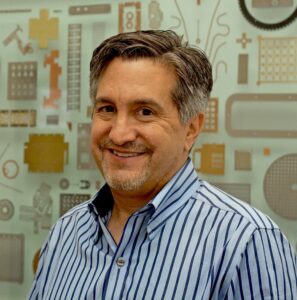This website uses cookies so that we can provide you with the best user experience possible. Cookie information is stored in your browser and performs functions such as recognising you when you return to our website and helping our team to understand which sections of the website you find most interesting and useful.
Straight from the DesignCon 2021 Trade Show Floor
At DesignCon 2021, Nolan Johnson from I-Connect 007, caught up with Charles Cohen, president of Fotofab. They discussed what the company does for the photonics industry, and how growth in the medical industry impacts his business.
DesignCon 2021 Trade Show Full Interview
Nolan Johnson: I’m speaking with Charles Cohen of Fotofab. Charles, tell us a little about your company.
Charles Cohen: We photochemically etch precision metal parts to custom specification. We can quickly produce very fine features, very thin metals, and very tight tolerances.
Johnson: The processes that you’re using are not that different from what’s used for printed circuit board fabrication, right?
Cohen: Correct. I would estimate roughly 70% of the same machinery is used. One of the key differences is that we’re etching from the top and the bottom, using a different type of chemistry, and holding tighter tolerances from A to B, top to bottom, of the metal. It’s a lot of conveyor-based equipment, and there’s some lithography on the front end of the process. There are about 10 processes to develop a flat part. Chemcut is an equipment supplier in both industries.

Chemical Etching Applications for DesignCon 2021 Attendees
Johnson: What are some of applications? What kind of parts can you manufacture?
Cohen: We do quite a bit of EMI shielding; that’s our bread and butter, connectors, encoders, and antennas as well. We’re pretty heavy in the photonics industry and make everything to custom requirements. In addition to the flat parts, we also apply coatings on the material and have a full tool and die shop so we can form parts into precise geometries be used in varying applications.
Johnson: Where are you based?
Cohen: We’re in Chicago, Illinois. We’re a day away from anywhere.
Current Market Trends for Chemical Etching
Johnson: What’s the current market for your product? Is it growing?
Cohen: We’re seeing a lot of growth in the medical industry We are starting to see strong growth in alternate fuel applications, and a lot of research in almost all industries. We’re seeing industries quickly rotate to alternate energy.
Johnson: What are some of the demands that these customers have? What are they looking to accomplish with the products?
Cohen: The neat thing about alt energy is that a lot of these parts are vacuum-bonded, so they’re layered. What we do is create multiple metal sheets with different configurations, and after they’re vacuum-bonded, it creates an intricate part that has holes and channels, which is great for gas, air, and heat distribution.
Johnson: How does somebody connect with you? How do you get a job into your shop?
Cohen: We’re very easy to find and work with, and our customers state so. Number one, you can go to our website, Fotofab.com. You can upload a drawing and submit an RFQ online. Number two, you can call us at 773-463-6211. Our technical engineers would be glad to help you.
Johnson: What file formats do you accept?
Cohen: We do like to work in AutoCAD (.step, .stp, .igs, .iges, .dxf, .dwg, .pdf), but we’ve said for many years that if you put it on a napkin, we can work with it.
Johnson: Where do you see the market going? Where do you anticipate seeing more business?
Cohen: We’re seeing the growth in medical as well as the defense side. Both industries are looking for smaller features, tighter tolerances, and high repeatability. We recently acquired new equipment that helps us with exactly that.

Future Growth for Photochemical Etching
Johnson: Great. Looking out three to five years, what do you see the Fotofab business looking like?
Cohen: We’re gearing toward smaller features and tighter tolerances. I do see that other manufacturing processes may infringe upon the chemical etching process, but they’re certainly not going to achieve the tolerances that we can meet time and again.
Johnson: I know that feature sizes are driving smaller and smaller for components because components are driving smaller and smaller, that’s on the board. What is driving your process to go smaller? What are the market drivers?
Cohen: Devices. Whether they are implanted, wearable, in an airplane, or in a hospital, our devices are becoming smaller.
Johnson: And that affects you and the reduced dimensions that you need to deliver?
Cohen: Exactly. With technology, everything’s moving faster, everything’s measuring things to greater decimals out to the right of the decimal point and quicker. That need for higher precision typically leads to smaller parts and parts that have can withstand harsher environments and preform in critical situations.
Johnson: Great. Excellent. Well, thanks for your time. This has been insightful.
Cohen: My pleasure. Thank you.

